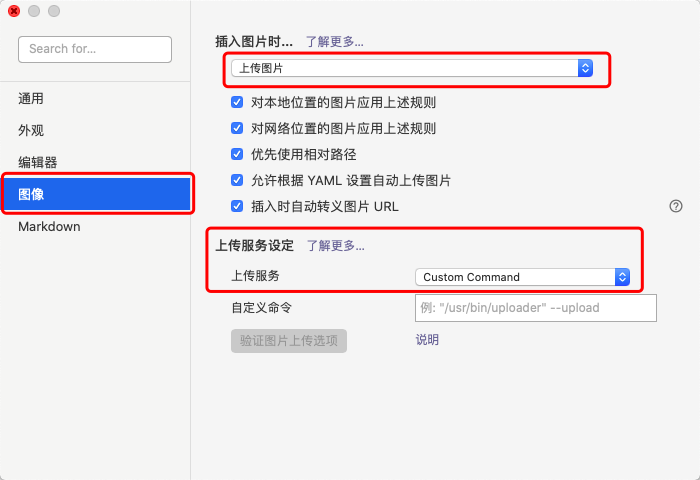前言
个人比较喜欢用 Typora 写文档,对于文档中的图片之前一直是手动上传到七牛云,复制地址,在粘回文档,比较累。就一直在想怎么能实现图片自动上传呢,然后最近就发现 window 版的 Typora 也支持自定义图床了(mac很久之前就支持了),就专门研究了下,下面就分享下怎么把图片自动上传到七牛云。先看下最后的实现效果:

前置条件
有 node 环境
编写脚本
我们先打开 Typora 的设置,选择到图像,插入图片时选择上传图片,下面的选项根据自己的需要选,下方的上传服务选择自定义命令( Custom Command )

自定义命令要输入的就是上传图片时会执行的命令,假入我们输入的是 node index.js 那么最后上传图片时执行的就是 node index.js xxx.jpg ,执行完成之后必须在控制台打印出最后的图片地址。
所以自定义命令我最后输入的是:
/Users/mac/.nvm/versions/node/v12.16.1/bin/node /Applications/qshell/index.js -file
上方的命令表示用 node 去执行 /Applications/qshell/ 下的 index.js 文件,-file 字段名,最后通过 file 取传入的图片路径。
特殊说明:
因为我 mac 上是用 nvm 管理 node 版本的,所以造成 typora 直接去执行 node 命令的时候,会报 node 命令不存在,所以我用的是 /Users/mac/.nvm/versions/node/v12.16.1/bin/node 绝对的 node 命令,如果你也用的nvm管理node,那你一定要找到你的node命令 。如果你没有用nvm等node管理工具,node 命令随处可执行,那么你就可以把 /Users/mac/.nvm/versions/node/v12.16.1/bin/node 换成 node
/Applications/qshell/index.js 是我脚本所在位置,使用过程中根据实际来,你的脚本在那个文件夹下,就改成你脚本的位置
例如我 window 上的命令就是
然后到 /Applications/qshell/ 目录下(这是我脚本所在位置,实际应用时到你脚本的存放位置)去执行下 npm init -y ,然后接着 npm i -D commander ,最后新建个 index.js 文件
index.js 内写入如下内容
1
2
3
4
5
6
7
8
9
10
11
12
13
14
15
16
17
18
19
20
21
22
23
24
25
26
27
28
29
30
31
32
33
34
35
36
37
38
| const program = require('commander');
const progress = require('child_process');
program.option('-file, --LocalFile <LocalFile>', '要上传的本地文件');
program.parse(process.argv);
const exec = (command) => {
return new Promise((resolve,reject) => {
progress.exec(command,(error,stdout,stderr)=> {
if (error) {
console.log(error)
reject()
} else {
resolve(stdout)
}
})
})
}
const upload = async () => {
const {LocalFile} = program.opts();
let fileName,res;
if (LocalFile.startsWith('https://') || LocalFile.startsWith('http://')) {
fileName = LocalFile.split('/');
fileName = fileName[fileName.length - 1];
res = await exec(`/Applications/qshell/qshell fetch ${LocalFile} blog -k notes/${fileName}`);
console.log(`https://static.jiabanmoyu.com/notes/${fileName}`)
} else {
fileName = LocalFile.split(/[\/|\\]/);
fileName = fileName[fileName.length - 1];
res = await exec(`/Applications/qshell/qshell fput --overwrite blog notes/${fileName} ${LocalFile}`);
console.log(`https://static.jiabanmoyu.com/notes/${fileName}`)
}
}
upload();
|
1
2
3
4
5
6
7
8
9
10
11
12
13
14
15
16
17
18
19
20
21
22
23
24
25
26
27
28
29
30
31
32
33
34
35
36
37
38
39
40
| const program = require('commander');
const progress = require('child_process');
program.option('-file, --LocalFile <LocalFile>', '要上传的本地文件');
program.parse(process.argv);
const exec = (command) => {
return new Promise((resolve,reject) => {
progress.exec(command,(error,stdout,stderr)=> {
if (error) {
console.log(error)
reject()
} else {
resolve(stdout)
}
})
})
}
const upload = async () => {
const {LocalFile} = program.opts();
let fileName,res;
if (LocalFile.startsWith('https://') || LocalFile.startsWith('http://')) {
fileName = LocalFile.split('/');
fileName = fileName[fileName.length - 1];
res = await exec(`qshell fetch ${LocalFile} blog -k notes/${fileName}`);
console.log(`https://static.jiabanmoyu.com/notes/${fileName}`)
} else {
fileName = LocalFile.split(/[\/|\\]/);
fileName = fileName[fileName.length - 1];
res = await exec(`qshell fput --overwrite blog notes/${fileName} ${LocalFile}`);
console.log(`https://static.jiabanmoyu.com/notes/${fileName}`)
}
}
upload();
|

